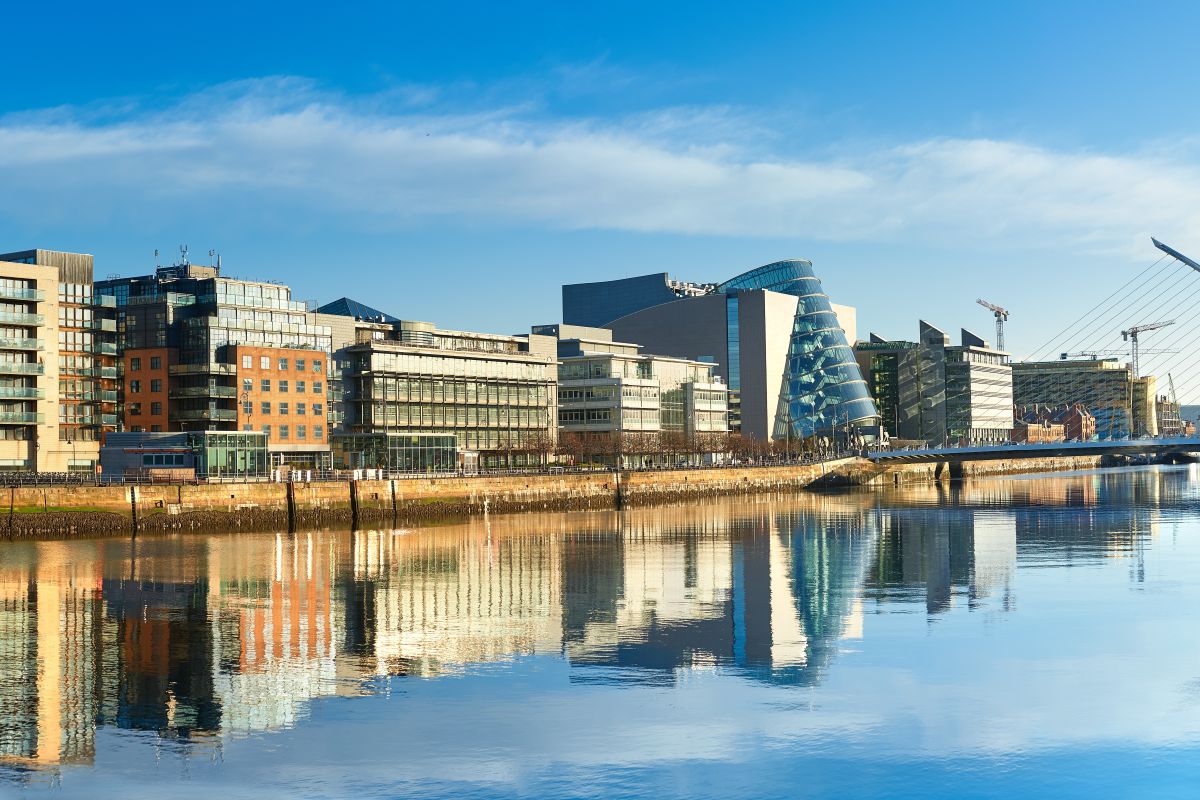Dublin, the capital of Ireland, is a charming blend of history, music, and a lively social spirit. Between Victorian pubs, literary heritage, and the brisk sea breeze, unfolds a city that combines old stories with youthful energy. Whether you’re strolling along the River Liffey for the first time or already have your favorite pub in the Temple Bar District — Dublin welcomes you with open arms, a pint of Guinness in hand, and a smile as warm as Irish rain.
Top Attractions in Dublin
Trinity College & The Book of Kells
Founded in 1592 by Queen Elizabeth I, Trinity College Dublin is Ireland’s oldest university and a symbol of knowledge and history. Its most famous treasure, the Book of Kells, dates back to the 9th century and was elaborately illustrated by Celtic monks with vibrant colors. It contains the four Gospels in Latin and is considered one of the most beautiful manuscripts of the Middle Ages. Particularly impressive is the Long Room, a 65-meter-long library holding more than 200,000 rare volumes. Its wooden shelves and lofty barrel vaults create an almost sacred atmosphere.
Fun Fact: The Jedi Archives Hall from Star Wars: Episode II bears a striking resemblance to the Long Room — proof that Dublin’s history inspires even galaxies far, far away.
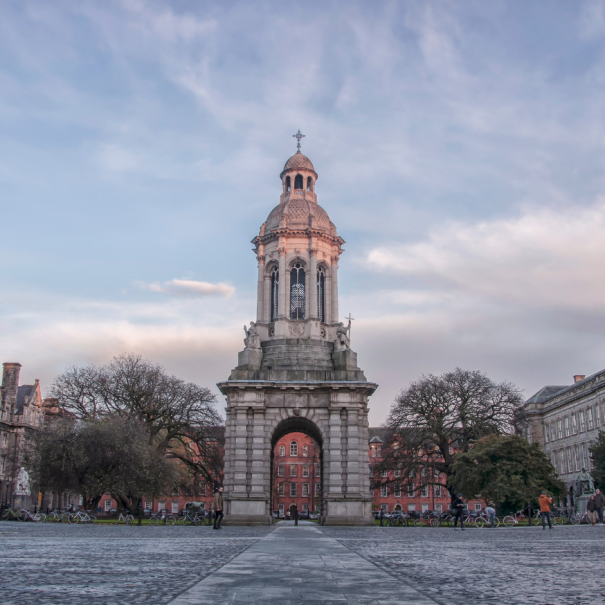
Dublin Castle
For over 700 years, Dublin Castle served as the administrative center of the British Crown in Ireland. Today, it’s a place where history, politics, and culture meet. Visitors can tour the magnificent State Apartments, where state receptions and inaugurations are still held today. Particularly striking is the contrast between the medieval foundations of the original fortress and the baroque opulence of the 18th-century chambers. The castle complex also houses the Chester Beatty Library, which contains one of the world’s most significant collections of manuscripts and religious texts.
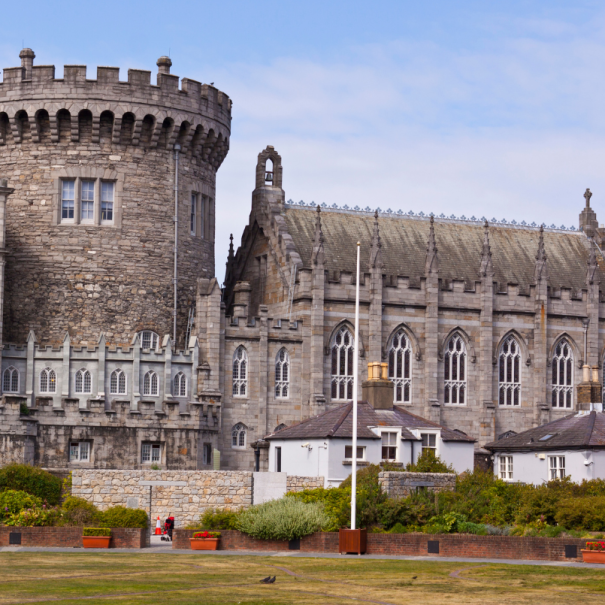
St. Patrick’s Cathedral
Ireland’s largest cathedral is not only an architectural masterpiece but also of great historical significance. Built in the 12th century, St. Patrick’s Cathedral honors Saint Patrick, the patron saint who, according to legend, converted the Irish to Christianity. The imposing Gothic building features tall arches, intricate stained-glass windows, and a distinctive 43-meter tower. Inside lies the tomb of Jonathan Swift, author of Gulliver’s Travels, who served as dean here. Surrounding the cathedral is a well-kept park — a peaceful retreat, especially in springtime.
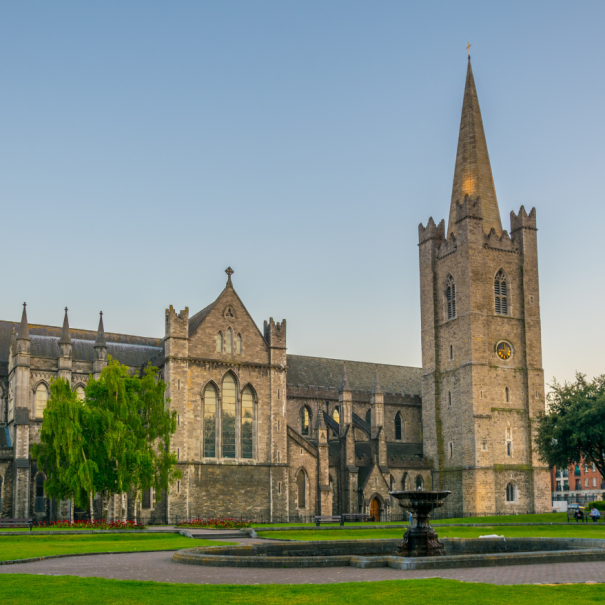
Temple Bar District
Dublin’s legendary pub district is the city’s beating heart — a maze of cobblestone streets, colorful façades, and live music echoing from nearly every doorway. Pubs, galleries, small shops, and restaurants line the narrow lanes. By evening, the area becomes the epicenter of nightlife, where locals and tourists mingle over Guinness and Irish folk tunes. On Saturdays, the Temple Bar Food Market offers fresh local produce and treats. Despite its popularity with visitors, Temple Bar has retained its charm — authentic, loud, and unmistakable.
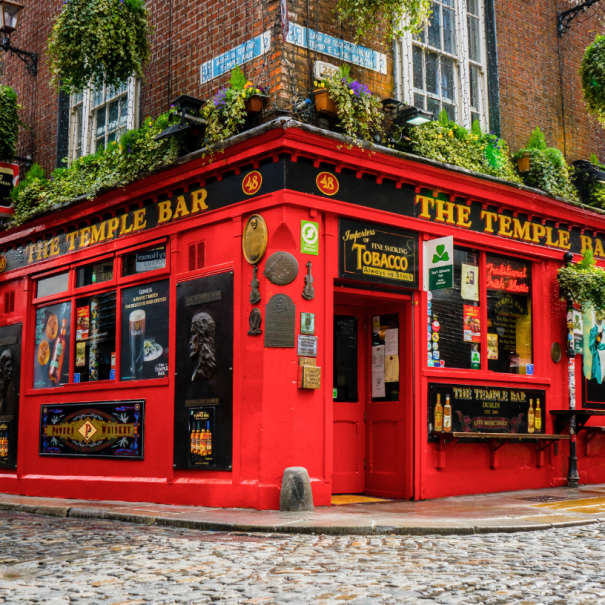
Ha’penny Bridge
Officially named the Liffey Bridge, the Ha’penny Bridge opened in 1816 as Dublin’s first pedestrian bridge. It earned its nickname from the half-penny toll once charged for crossing. With its elegant white cast-iron arch, it is one of Dublin’s most photographed landmarks. Especially at night, when lit by lanterns and reflected in the Liffey’s waters, it exudes a romantic charm. Today, it serves not only as a practical crossing but also as a symbol of Dublin’s connection between history and modernity.
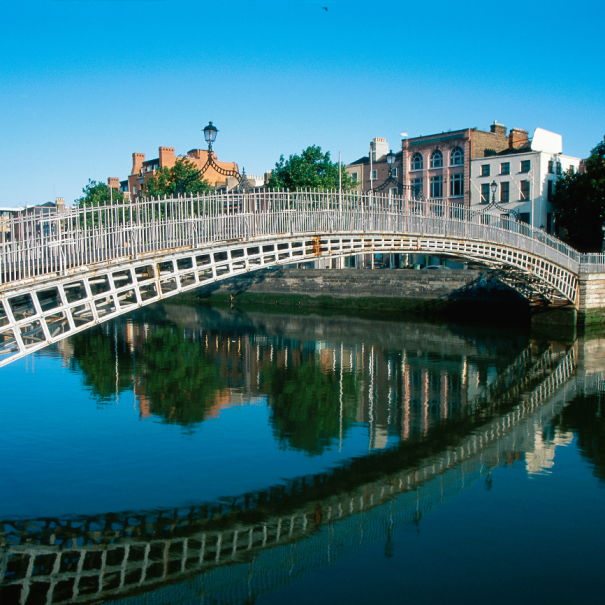
Best Scenic Viewpoints
Guinness Storehouse Gravity Bar
The Guinness Storehouse is more than a museum — it’s an experience dedicated to Ireland’s most famous beer. Across seven floors, the exhibition guides visitors through the history, brewing process, and advertising culture of the brand. The highlight awaits at the Gravity Bar, a glass-walled rooftop lounge offering a 360° panoramic view over all of Dublin — from the spires of St. Patrick’s Cathedral to the green hills of the Wicklow Mountains. With a freshly poured Guinness, sunset views here are truly unforgettable.
Killiney Hill Park
About 14 kilometers south of the city center lies Killiney Hill Park, a favorite getaway for walkers and nature lovers. The trail up the hill winds through dense forests and offers spectacular views over Dublin Bay, the Wicklow Mountains, and, on clear days, even the Welsh coast. At the top stands a distinctive 18th-century obelisk, built to provide employment during times of famine. The ascent takes about 30 minutes and rewards visitors with one of Ireland’s most breathtaking vistas.
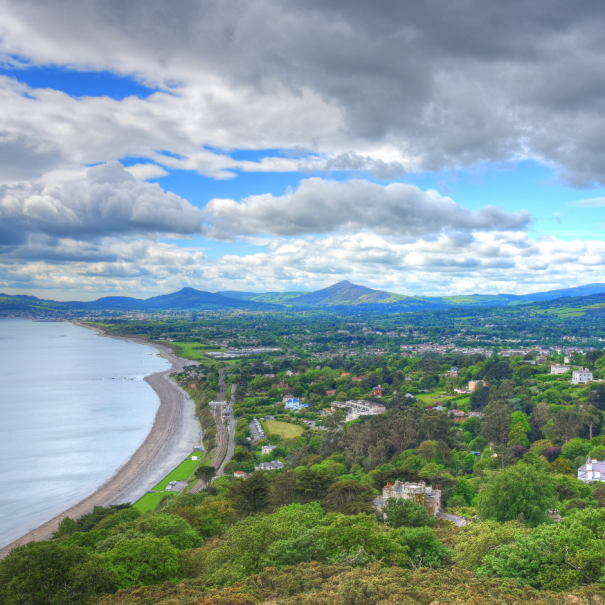
The Spire
Also known as the Monument of Light, the Spire of Dublin is a modern city landmark. This 120-meter-tall stainless steel column rises from O’Connell Street and symbolizes the city’s modern, upward spirit. Built in 2003 on the site of the former Nelson’s Pillar, it reflects changing light throughout the day. At night, its tip glows softly, pointing skyward — a symbol of hope and progress in a city steeped in history.
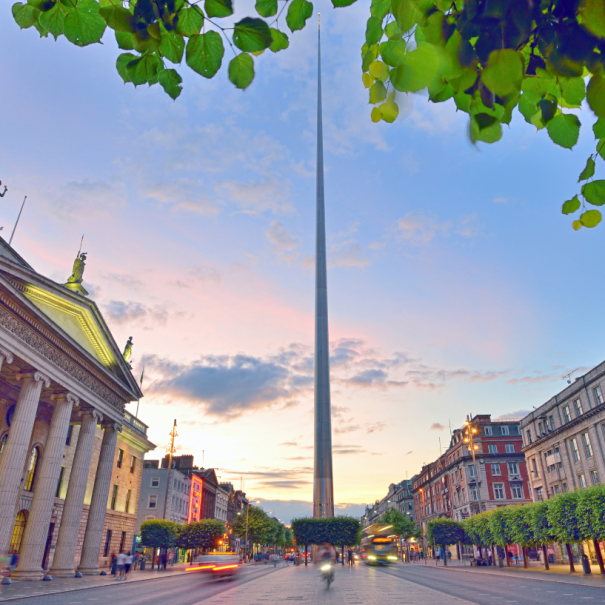
Culinary Highlights For Food Lovers
The Winding Stair
Located right by the River Liffey, The Winding Stair combines traditional Irish cuisine with contemporary flair. The cozy restaurant owes its name to the winding staircase leading to the upper floor. The menu features dishes such as freshly caught salmon, local lamb, and homemade desserts — all prepared using regional ingredients. With a view of the Ha’penny Bridge, dining here feels special. The building once housed a famous bookshop, adding a touch of literary nostalgia to the experience.
Chapter One
Awarded a Michelin star, Chapter One ranks among Dublin’s finest restaurants. Situated beneath the Dublin Writers Museum, it offers an elegant fusion of Irish and international haute cuisine. Chef Mickael Viljanen creates artful dishes that reinterpret seasonal ingredients with creativity and precision. The refined interior and attentive service make every visit a memorable culinary journey.
Gallagher’s Boxty House
In the heart of Temple Bar, Gallagher’s Boxty House is devoted to the traditional Irish potato dish “Boxty.” This hearty pancake comes in countless variations — with beef, fish, or vegetarian fillings. The rustic atmosphere, warm service, and a pint of Guinness make it the perfect spot for authentic Irish comfort food. A favorite among guests is the Boxty Platter, a sampler of the restaurant’s most popular variations.

Insider Tips & Hidden Gems
Iveagh Gardens
The Iveagh Gardens are a hidden gem right in the city center. Just a few minutes from bustling St. Stephen’s Green, they offer a peaceful escape with waterfalls, rose gardens, and ornate fountains. Designed in the 19th century in Victorian style, the park is famous for its well-kept hedge maze. Despite being public, the gardens are still little known among tourists — ideal for a quiet picnic or a relaxing read surrounded by greenery.
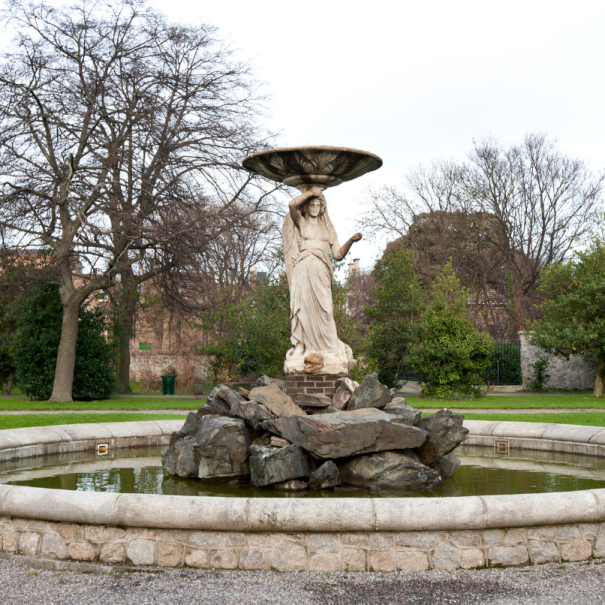
Marsh’s Library
Next to St. Patrick’s Cathedral stands Marsh’s Library, one of Ireland’s oldest public libraries, opened in 1707. Between dark wooden shelves and the scent of old books, visitors are transported back in time. Over 25,000 volumes, including rare works from the 15th and 16th centuries, fill the rooms. Some books remain chained to their shelves — a reminder of when books were more valuable than gold. A must-visit for literature lovers.
The Cobblestone
Located in the Smithfield district, The Cobblestone is one of Dublin’s last authentic music pubs. Locals, musicians, and curious visitors gather here, united by a love for traditional Irish music. Every evening, local artists play spontaneous sessions — no stage, just pure sound in the middle of the pub. The atmosphere is warm, the tunes genuine, and the Guinness always perfectly poured. Here, you can truly hear the soul of Dublin.
Museums for Culture and History Enthusiasts
National Museum of Ireland
A must for history enthusiasts: the National Museum of Ireland is a treasure trove of Irish heritage. The Archaeology Department on Kildare Street is particularly impressive, showcasing Celtic gold, weapons, jewelry, and the famous bog bodies that offer an astonishingly well-preserved glimpse into life more than 2,000 years ago. Other branches of the museum focus on natural history, decorative arts, and folklore.
EPIC – The Irish Emigration Museum
Modern, interactive, and moving — the EPIC Museum in the Docklands district tells the story of Irish emigration. Through interactive displays, visitors learn how millions of Irish people left their homeland and left a mark around the world. Digital stations, projections, and eyewitness accounts make the experience vivid and emotional. You can even trace your own Irish family roots here.
Dublin Writers Museum
Dublin is a UNESCO City of Literature, and this museum celebrates its literary greats — Joyce, Yeats, Wilde, and others. In the elegant rooms of a Georgian townhouse, visitors can admire manuscripts, letters, and personal belongings that offer fascinating insights into Dublin’s literary heritage. Located at Parnell Square, the museum, together with the nearby James Joyce Centre, forms a paradise for book lovers.

Discover 70+ cities worldwide with professional audio guides – and counting! Thanks to integrated navigation, you’ll easily find your way, even without an internet connection. Whether it’s famous highlights or hidden gems – Plazes brings exciting tours and vivid stories straight to your smartphone.
Shopping & Souvenirs
Dublin’s best-known shopping street, Grafton Street, is a feast for the senses: street musicians, boutiques, and flower stalls create an atmosphere that delights even reluctant shoppers. A short detour to Bewley’s Café is a must. Nearby, the Powerscourt Townhouse Centre, set in a grand Georgian building, blends shopping and culture — featuring designer stores, vintage shops, and artisan boutiques. Lovers of handcrafted Irish textiles shouldn’t miss Avoca, where colorful blankets, scarves, and candles make for perfect souvenirs — a cozy piece of Ireland to take home.
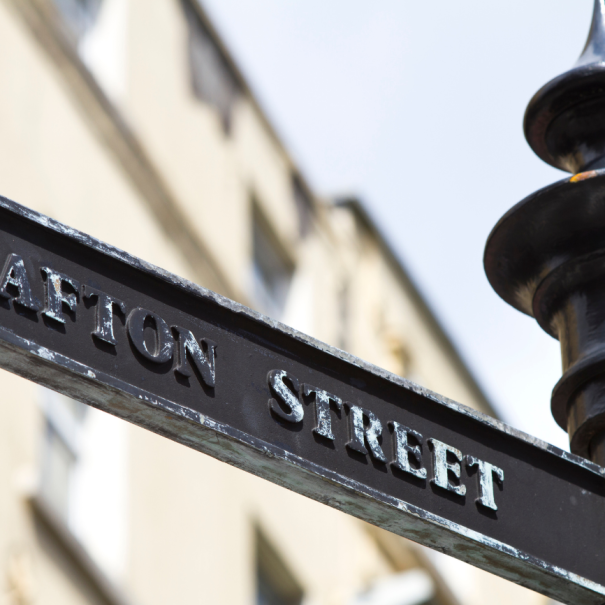
Tips for Cruise Passengers
Cruise ships usually dock at Dublin Port Terminal 3, about 4 kilometers from the city center. Shuttle buses run regularly between the port and downtown, taking around 15 minutes. Alternatively, taxis and rental cars are available, and public buses (e.g. routes 53 and 147) also connect to the city.
Another docking point is Dún Laoghaire Port, about 12 kilometers south of central Dublin. This charming seaside suburb offers a lovely promenade, quaint cafés, and a direct DART train connection to the city center — only a 25-minute ride. From the harbor, you’ll enjoy stunning views of Dublin Bay and can begin a scenic coastal walk right away.
Tip: Plan at least half a day to explore Dublin’s main highlights — and don’t forget to leave time for a pint in a pub; it’s an essential part of the experience.
Tips for Solo Travelers
Dublin is a safe, open, and friendly city — perfect for solo adventurers. The public transport system is well-developed: buses, DART trains, and trams (Luas) will get you anywhere. For visitor info, stop by the Visit Dublin Centre on Suffolk Street. If you’re looking to meet people, many hostels or pub crawls are great for socializing. And don’t worry — having a pint alone in Dublin isn’t a faux pas; it’s practically a cultural ritual.
Conclusion
Dublin is a city full of stories, music, and joy. Among its medieval streets, modern museums, and cozy pubs, every visitor finds their own favorite spot. Whether you’re walking in the footsteps of great writers, gazing over the bay from Killiney Hill, or simply drifting through the Temple Bar District — Dublin enchants with its unique blend of charm, culture, and heart. And the moment a stranger greets you with a cheerful “Howya!”, you’ll know: you’re truly welcome here.
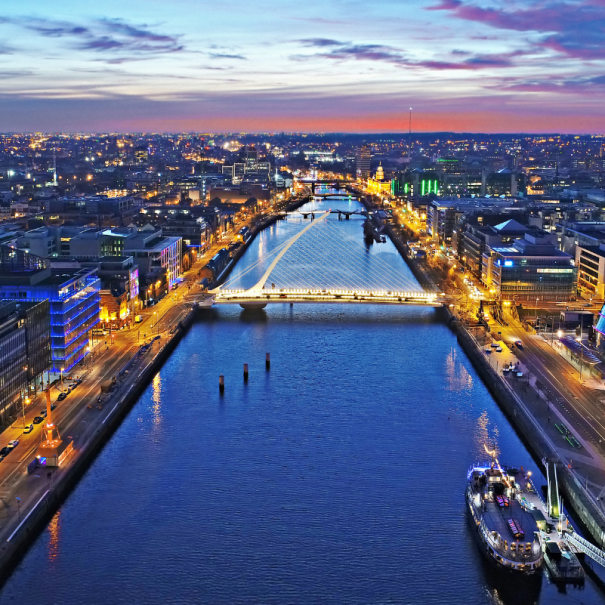
FAQs:
1. How much time should you plan for Dublin?
For the classics like Trinity College with the Book of Kells, Dublin Castle, Temple Bar, and one or two museums, two days are enough. Those who want to include excursions (such as the Howth coastal cliffs or Malahide Castle) or enjoy more pubs and live music should plan for three to four days.
2. Is a trip to the coast worth it, and how can you get there quickly?
Yes! With the DART train, you can reach Howth (cliff walks, seals at the harbor) or Dún Laoghaire (promenade, Martello towers) in just 30 minutes. You can buy tickets via the app or at the ticket machines. Trains run every 10 to 15 minutes.
3. Should you book tickets in advance, for example for the Guinness Storehouse?
Be sure to book online in advance — especially on weekends and during the high season, as time slots often sell out beforehand. This also helps you avoid long waiting lines.
4. How accessible and family-friendly is Dublin?
Many museums and public transport services are accessible. Buses are equipped with ramps, and the Luas trams have level boarding. In the Temple Bar district, the cobblestone streets can be a bit bumpy, but parks like Phoenix Park or St. Stephen’s Green are perfectly designed for strollers.
5. Which neighborhoods beyond Temple Bar should you explore to experience authentic Dublin?
Stroll through Stoneybatter and Smithfield for cozy pubs, small galleries, and more laid-back live sessions. Portobello entices with its canal-side charm, cafés, and vintage shops — perfect for a quiet evening away from the hustle and bustle.

